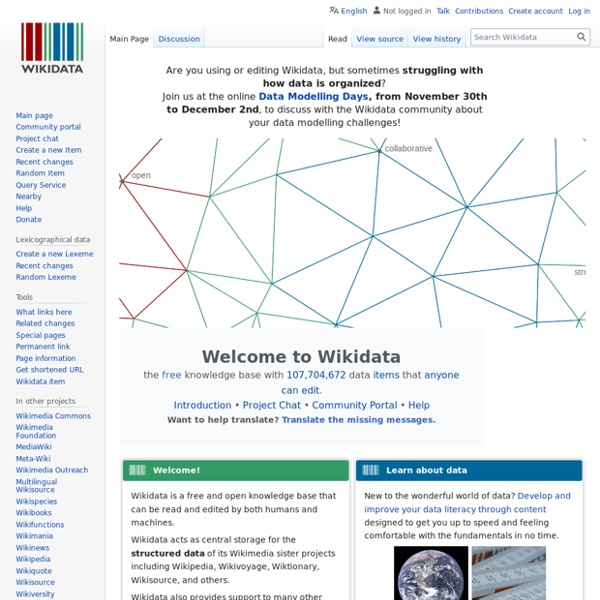



https://www.wikidata.org/wiki/Wikidata:Main_Page
Related: DIGITAL HUMANITIES • Bases de données urbanisme et environnement • Grafic information • DATAEighteenth Century Collections Online: Part I Eighteenth Century Collections Online contains every significant English-language and foreign-language title printed in the United Kingdom between the years 1701 and 1800; Part I includes 135,000 printed works, comprising more than 26 million scanned facsimile pages. While the majority of works in ECCO are in the English language, researchers will also discover a rich vein of works printed in Dutch, French, German, Italian, Latin, Spanish, and Welsh. Full-text searching across all 26 million pages enables users to explore a vast range of books and directories, bibles, sheet music, sermons, advertisements, and works by both celebrated and lesser-known authors. Researchers will also find rare works from women writers of the eighteenth century, collections on the French Revolution, and numerous editions of the works of Shakespeare.
Common Metadata Repository (CMR) *NOTE: The Common Metadata Repository (CMR) has replaced NASA's Earth Observing System (EOS) Clearing House (ECHO). What is CMR? NASA's Common Metadata Repository (CMR) is a high-performance, high-quality, continuously evolving metadata system that catalogs all data and service metadata records for NASA's Earth Observing System Data and Information System (EOSDIS) system and will be the authoritative management system for all EOSDIS metadata. These metadata records are registered, modified, discovered, and accessed through programmatic interfaces leveraging standard protocols and APIs. China Biographical Database Project (CBDB) Social network analysis (SNA) provides an alternative to the factor-based approach in L. Stone's discussion of prosopography. Charles Wetherell writes: “Conceptualizing community as collections of personal relationships … provides historians with a blueprint for evaluating when, how and why people in the past used kin and non-kin in the course of their lives. The findings of social network analysts that people need and seek emotional and economic support of different kinds, from different kinds of people, suggest new analytical imperatives.
Institut humanités numériques Upload your own docs to our new (beta) Text Analyzer tool to see research related to your topics! This paper approaches Corinne, ou l’Italie through an inter-disciplinary lens, drawing on literary, historical, and digital methodologies. If Corinne is first and foremost a Romantic novel that foregrounds the love plot between Corinne and Oswald, it is as much a novel about the role of women in society, articulated through the figure of the femme de génie. The plot of the femme de génie finds its expression through the trope of sociability, which I analyze through a social network analysis of the characters in the narrative and a computational analysis of collocates. I argue that through the constellation of sociability in the novel and the national allegories that accompany it, Staël evokes an enduring partiality for an Enlightenment ideal of sociability that remains deeply connected with female emancipation.
The Oxford Friars Project “Great Houses Make Not Men Holy: Mendicant Architecture in Medieval Oxford” Created by Jim Knowles (NC State) and Michal Koszycki (Princeton University) Please note: the film includes an audio track, so turn on your speakers or plug in headphones prior to viewing. There is a nine-second gap at the beginning of the playback. Film begins at 00:10. Film ends at 11:30.
IUCN Red List of Threatened Species Spatial Data & Mapping Resources The IUCN Red List of Threatened Species™ contains global assessments for 105,732 species. More than 75% of these (81,323 species) have spatial data. The spatial data provided below are for comprehensively assessed taxonomic groups and selected freshwater groups. Center for Spatial Research On the eve of an historic and controversial peace agreement in Colombia we have launched an investigation into the spatial characteristics of the decades long conflict between multiple state and non-state actors in the country. We have provisionally titled this research Conflict Urbanism: Colombia. Our work is still in the beginning phases. We have formed a relationship with the interdisciplinary M.A. Program in Peacebuilding at Universidad de los Andes in Bogotá. We aim to analyze and visualize the documented aspects of the conflict in Colombia in order to put forward policy recommendations for the transitional justice and peacebuilding process.
Debates in the Digital Humanities In late summer of 2010, I arrived on the campus of St. Norbert College in De Pere, Wisconsin. I was a newly minted assistant professor, brimming with optimism, and the field with which I increasingly identified my work—this “digital humanities”—had just been declared “the first ‘next big thing’ in a long time” by William Pannapacker in his Chronicle of Higher Education column.1 “We are now realizing,” Pannapacker had written of the professors gathered at the Modern Language Association’s annual convention, “that resistance is futile” (“MLA and the Digital Humanities”). So of course I immediately proposed a new “Introduction to Digital Humanities” course for upper-level undergraduates at St. Norbert. My syllabus was, perhaps, hastily constructed—patched together from “Intro to DH” syllabi in a Zotero group—but surely it would pass muster.